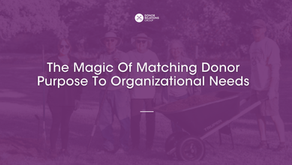The Seagull Has Landed—And Left You the Mess
- Lynne Wester

- Jul 30
- 4 min read

Let’s talk about a behavior that is slowly but surely sabotaging nonprofit professionals everywhere—and not in some grand dramatic implosion, but through the slow, soul-sucking weight of other people’s dumped responsibilities.
It’s called seagulling.
You’ve seen it. You’ve probably experienced it. You may have even done it yourself (gulp). Seagulling is when someone—usually in a position of power or positional authority—flies into a meeting or your inbox with a new “priority,” plops it into your lap with zero context, deadline, or support, and then promptly disappears.
Fly in, drop poop and leave.
No follow-up. No accountability. No partnership. Just a big ol’ “this needs to get done” with the expectation that you, superhero that you are, will just figure it out.
Sound familiar?
Seagulling is more than annoying. It’s damaging. It breaks trust, burns people out, and perpetuates the deeply broken belief that someone else's lack of planning is your emergency.
In nonprofit work—where capacity is already stretched thinner than a budget on June 29—it’s particularly insidious. Because here’s the thing: our work is purpose-driven. We care. We say “yes.” We show up. So, when a seagull circles above and squawks “I need this by Friday,” our instinct is to roll up our sleeves and get it done.
But at what cost?
Every time you absorb someone else’s dropped ball, every time you reorganize your entire week to accommodate a “drive-by deliverable,” you’re trading something. Focus. Energy. Integrity. The strategic work you actually planned to do that day. And if you're in donor relations, you're trading the intentional donor experience you’ve been painstakingly curating for someone else's chaos.
That’s not sustainable. That’s not strategic. And it sure as heck isn't donor-centric.
So why does seagulling happen in the first place?
Well, a few reasons. Some people simply lack organizational awareness. They don’t know what you’re juggling because they never ask. Others are in a constant state of reaction, and instead of doing the hard work of prioritization, they offload their stress onto whoever is nearest. And let’s be honest: some people do it because they can. They’ve never been told no. They've never had to explain themselves. They've learned that they can drop things on others and face no consequences.
Which brings me to the real heart of this issue: boundaries.
The only way to stop a seagull from landing in your lap is to build a boundary it can’t perch on. That means developing the language, the confidence, and the culture to say, “No, not right now.” Or better yet, “Yes—but here’s what I’ll need in order to do that well.”
Setting boundaries isn’t about being unhelpful. It’s about being strategic. You cannot do meaningful, thoughtful work for donors—or anyone else—if you’re constantly being pulled into urgent tasks that weren’t yours to begin with.
And let’s be clear: every time you allow seagulling, you’re not just hurting yourself. You’re training the people around you that you’re a landing pad. You’re reinforcing a cycle that tells your team, “If you don’t plan, don’t worry—someone else will rescue you.”
That’s not a culture of excellence. That’s a culture of avoidance. And nonprofits? We can’t afford that.
So how do we shift?
It starts with self-awareness. Recognize the signs of seagulling and how you typically respond. Do you drop everything? Do you vent but still say yes? Do you silently seethe while sending a 10 p.m. email to meet a bogus deadline? Notice those patterns. Then interrupt them.
Next, get clear on your own priorities. You can’t set boundaries if you don’t know what’s important. When a seagull drops something on your desk, you should be able to say, “That’s not currently aligned with the goals I’m working toward. Can we revisit this in our next prioritization meeting?” Or, “I’m happy to help—once I finish the impact report that’s due this week. Would next Thursday work?”
Is that uncomfortable? Sure. At first. But boundaries are like muscles. You have to use them to build them. And every time you do, you strengthen your own capacity and give permission to others around you to do the same.
Leaders: this is where I need you to really lean in. If you’re a manager, director, VP, or ED, and you’re seagulling your staff, it’s time to stop. Right now. I say this with love, but also with urgency. Your job is to empower and protect your team’s focus—not disrupt it. If you need something done, engage in conversation. Provide context. Ask what’s possible. Don’t bark a deadline and vanish.
And if you see someone being seagulled by someone else? Advocate for them. Model boundaries. Normalize asking for clarity, deadlines, and the purpose behind a request. Because when you stop seagulling, and when you stop allowing it, everyone’s work gets better.
The donor experience gets better.
The team dynamic gets better.
And you? You get to do the work you were actually hired to do—not clean up someone else’s mess.
Seagulling is lazy. Boundaries are brave.
Let’s be the brave ones.
Let’s teach people how to treat our time.
Let’s fly higher.
Written by Lynne Wester





